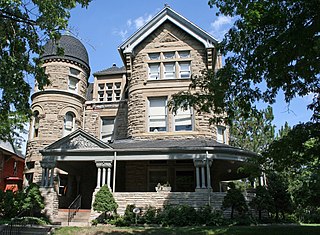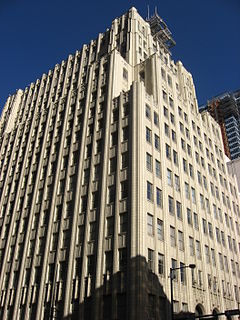Related Research Articles

William LaBarthe Steele was an important architect of the Prairie School during the early twentieth century. A graduate of the University of Illinois, Steele worked in the office of renowned architect Louis Sullivan in Chicago, Illinois 1897–1900. He relocated to Pittsburgh, Pennsylvania to gain additional experience with three other architectural firms.
Purcell & Elmslie (P&E), as it was most widely known, was a progressive American architectural practice. P&E was the second most commissioned firm of the Prairie School, after Frank Lloyd Wright. The firm was active from 1917 to 1921.

The architectural firm of Starrett & van Vleck, often spelled Starrett & Van Vleck, specialized in the design of early 20th century department stores primarily in New York City. The partner Goldwin Starrett, brother of Colonel William A. Starrett, had worked for four years in the Chicago office of Daniel Burnham. Included in their designs were the New York City flagship stores of Lord & Taylor, Bloomingdale's, Saks Fifth Avenue, Abraham & Straus, and Alexander's. The Lord & Taylor Building, located on Fifth Avenue between 38th and 39th Streets, was completed in 1914 and was Starrett & van Vleck’s first major department store and is a New York City designated landmark.

Wilson Brothers & Company was a prominent Victorian-era architecture and engineering firm established in Philadelphia, Pennsylvania, that was especially noted for its structural expertise. The brothers designed or contributed engineering work to hundreds of bridges, railroad stations and industrial buildings, including the principal buildings at the 1876 Centennial Exposition. They also designed churches, hospitals, schools, hotels and private residences. Among their surviving major works are the Pennsylvania Railroad, Connecting Railway Bridge over the Schuylkill River (1866–67), the main building of Drexel University (1888–91), and the train shed of Reading Terminal (1891–93), all in Philadelphia.

Joseph Warren Yost (1847–1923) was a prominent architect from Ohio whose works included many courthouses and other public buildings. Some of his most productive years were spent as a member of the Yost and Packard partnership with Frank Packard. Later in his career he joined Albert D'Oench at the New York City based firm D'Oench & Yost. A number of his works are listed for their architecture in the U.S. National Register of Historic Places (NRHP).

James Hamilton Windrim was a Philadelphia architect who specialized in public buildings.

Henry deCourcy Richards, also spelled Henry deCoursey Richards, was an American architect who worked in Philadelphia. He designed many buildings that are listed on the National Register of Historic Places for their architecture.

William A. Lang (1846–1897) was an architect active in Denver, Colorado from 1885 to 1893. On his own or in partnership he designed a number of buildings that survive and are listed on the U.S. National Register of Historic Places. Lang partnered with Marshall Pugh to form Lang & Pugh in 1889. The firm also employed Reinhard Schuetze for a time.

Cramp & Co. was a building company in Philadelphia. Many of its works are listed on the U.S. National Register of Historic Places. It worked sometimes in conjunction with architect Henry deCourcy Richards.

Frank J. Nies was an American architect best known for having designed numerous Delaware, Lackawanna & Western Railroad stations, at least fifteen of which have been listed on the U.S. National Register of Historic Places : He sometimes worked with the railroad's chief engineer, Lincoln Bush. Before working for the Delaware, Lackawanna & Western, Nies was a partner in the architectural firm Finkler & Nies, with Adolph Finkler, in Chicago in 1896.

McKissack & McKissack is an American architecture and engineering firm based for many years in Nashville, Tennessee, and now based in New York City and Washington, D.C. Founded in 1905, it was the first African-American-owned architectural firm in the United States and is the oldest African American-owned architecture and engineering firm in the country.
Wheeler & Runge was an American architectural partnership based in Charlotte, North Carolina. The series of partnerships formed by Oliver Duke Wheeler also included Wheeler, Runge & Dickey. and Wheeler & Stern.
Palliser, Palliser & Company was a Bridgeport, Connecticut, and New York City architectural firm and publisher of architectural pattern books.

The Mesker Brothers Iron Works and George L. Mesker & Co. were competing manufacturers and designers of ornamental sheet-metal facades and cast iron storefront components from the 1880s through the mid-twentieth century. The Mesker Brothers Iron Works was based in St. Louis, Missouri, and was operated by brothers Bernard and Frank Mesker. The George L. Mesker Company was operated by a third brother, George L. Mesker, and was based in Evansville, Indiana. The Mesker brothers were the sons of John Mesker who operated a stove business in Evansville and later galvanized iron for buildings. The three brothers learned their iron-working skills from their father.
James Mackson McMichael, known as James M. McMichael, was an American architect. Several buildings he designed are listed on the National Register of Historic Places.
Linthicum & Linthicum was an architectural firm in North Carolina. It was a partnership of Hill Carter Linthicum (1860-1919) who was a prolific architect, and H. Colvin Linthicum, his son.
Henry H. Kendall was an American architect from Boston, Massachusetts. He wrote a letter to the U.S. Civil Service commission critiquing the low pay for government architects. Kendall was the senior partner in the firm Kendall, Taylor & Company. Several of his or the firm's works are listed on the U.S. National Register of Historic Places, for their architectural merit.

James C. Bucklin (1801-1890) was an American architect working in Providence, Rhode Island.

William R. Walker was an American architect from Providence, Rhode Island, who was later the senior partner of William R. Walker & Son.

William N. Bowman was a prolific architect in Colorado.
References
- 1 2 Sandra L. Tatman. "Steele, William (1839 - 1908)". Philadelphia Architects & Buildings. Retrieved August 11, 2019.
| This article about a United States architect or architectural firm is a stub. You can help Wikipedia by expanding it. |